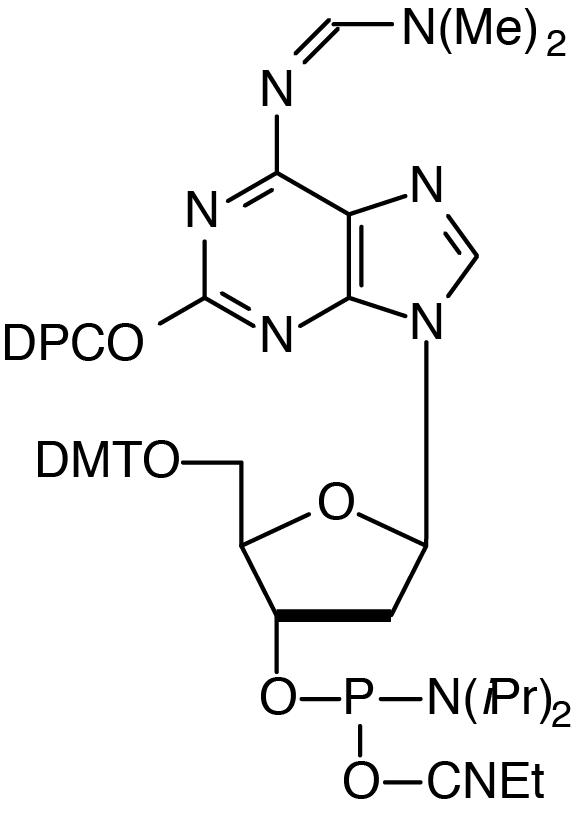| dmf-isodG-CE Phosphoramidite |

Catalog Number: 10-1078-xx
Description: dmf-isodG-CE Phosphoramidite
5'-Dimethoxytrityl-O2-diphenylcarbamoyl-N6-dimethylaminomethylidene-
2'-deoxyisoGuanosine,3'-[(2-cyanoethyl)-(N,N-diisopropyl)]-
phosphoramidite |
| Formula: C56H62N9O8P |
M.W.: 1020.13 |
F.W.: 329.21 |
Diluent: Anhydrous Acetonitrile |
| Coupling: No changes needed from standard method recommended by synthesizer manufacturer.Mild Deblocking Mix Required. Use 2.5-3% DCA instead of TCA |
| Deprotection: No changes needed from standard method recommended by synthesizer manufacturer. |
| Storage: Freezer storage, -10 to -30°C, dry |
| Stability in Solution: 2-3 days |
| Please Note: These products are supplied under license from EraGen Biosciences, Inc. US Patents 5,432,272, 6,001,983, 6,037,120, and 6,140,496. |
DUPLEX EFFECTS
The design of primers is frequently complicated by the degeneracy of the genetic code. Three strategies are now available to confront this problem. In the first, a mixed base addition (N) is used to form the degenerate site. This approach is best if the number of degenerate sites is small. A second option is the use of 2’-deoxyInosine or 2’-deoxyNebularine which exhibit low, but unequal, hydrogen bonding to the other four bases. The third option is the use of a universal nucleoside. In this strategy, the base analog does not hybridize significantly to the other four bases and makes up some of the duplex destabilization by acting as an intercalating agent. 3-Nitropyrrole 2’-deoxynucleoside (M) is the first example of a set of universal bases. Subsequently, 5-nitroindole was determined to be an effective universal base and to be superior to 3-nitropyrrole, based on duplex melting experiments.
The modified bases designated P and K show considerable promise as degenerate bases. The pyrimidine derivative P, when introduced into oligonucleotides, base pairs with either A or G, while the purine derivative K base pairs with either C or T. A dP dK mix also can serve as a mixed base with much less degeneracy than dA dC dG dT (N).
Unnatural base pairs display unique abilities in duplex DNA and in nucleic acid and protein biosyntheses. A standard Watson and Crick base pair is formed between iso-C and iso-G, but the hydrogen bonding pattern is quite different from the natural base pairs A-T and C-G. (The 5-methyl analogue was chosen as the synthetic target due to the reported instability of 2’-deoxyisocytidine caused by deamination during oligonucleotide synthesis or deprotection.)
The unnatural base pair between 7-(2-thienyl)-imidazo[4,5-b]pyridine (Ds) and pyrrole-2-carbaldehyde (Pa) is formed by specific hydrophobic shape complementation. The shape of the Ds-Pa pair is different from those of the natural A-T and G-C pairs, but the Ds-Pa pair works together with the natural pairs in in vitro replication and transcription. Pa also functions as a template base for incorporating another unnatural base, 2-amino-6-(2-thienyl)purine (s), into RNA. The s base also acts as a unique fluorescent base analog in DNA and RNA fragments. dDss is strongly fluorescent and is useful as a fluorescent tag for DNA detection. dDss also forms a base pair with dPa. Biotin PaTP can be site-specifically incorporated into RNA, opposite dDs at a desired position in DNA templates, by T7 transcription. Similarly, the fluorescent s base can be site-specifically incorporated into RNA opposite dPa in DNA templates.
If you cannot find the answer to your problem then please contact us or telephone +44 (0)1954 210 200